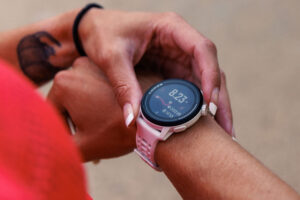
Image courtesy of COROS
No sports watch delivers a bang for your buck quite like the Pace series from COROS, and with today’s release of the COROS Pace 3 — featuring dual-band GNSS, off-line music support, and up to 38 hours of battery life with tracking and touchscreen functionalities — the fast-growing brand is clearly trying to further outpace its competitors.
Perhaps most impressive of all is that COROS has been able to pack in a bunch of new features while keeping the lightweight vibe of the Pace lineup intact. Coming in at 41.9-by-41.9-by-13 mm in size, the Pace 3 is actually smaller than its predecessor, though only marginally so. It maintains the 1.2-inch 240-pixel MIP display as before, and weighs 38 grams with a silicone band, which is only 2 grams heavier than the Pace 2.
But in that package rolls so much functionality, and this launch timed for the week of the 171-kilometer UTMB 2023 in Chamonix, France, where runners from around the world gather for one of the most iconic ultramarathons in the world. The COROS brand has proven to be a favorite among the ultra community, with 29.5 percent of Western States finishers this past summer sporting a COROS watch.

Image courtesy of COROS
The Pace series has long been the entry point watch for COROS, with the pricier and more full-featured Vertix and Apex lineup frequently in the spotlight (elite ultrarunner Kilian Jornet, for example, has his own branded Apex 2 Pro watch). Yet, with the Pace 3 being the first budget-level sport watch to have dual-frequency GNSS (the L5 and L1 signals work together to minimize disruptions due to reflections off of buildings and mountains), it could be a game-changer in the industry.
And, at $229, the price tag remains amazingly competitive. In fact, based on COROS releasing a comparison sheet that shows how the Pace 3 stacks up against various Garmin Forerunner devices, it’s clear that COROS is taking aim at the market leader among runners.
Spoiler: In many respects, the Pace 3 wins out. In standard GPS mode, the Pace 3 delivers 38 hours of battery life, and while using all-systems mode (functionally pulling from major satellite systems like GPS, GLONASS and Galileo simultaneously), it measures in at 25 hours. With dual-frequency enabled, COROS says it gets 15 hours. All of those metrics beat out Garmin’s lower- and middle-tier Forerunners, the 55 and 255/265.

Image courtesy of COROS
Further helping the Pace 3 is the addition of a Trail Running profile, something that was noticeably missing from the Pace 2 and somewhat shoehorned that device as a “road runners” watch. It also adds hiking and various winter activities that were not present on the Pace 2 (though they are slated to be added on that device before 2024). The Pace 3 has a barometric altimeter, electronic compass, temperature sensor, and, new to this model, a pulse oximeter.
The newly released watch has the opportunity to store music offline, though COROS devices only store music in mp3 format, which isn’t as usable as what Garmin or some smartwatches are capable of though Spotify downloads.
While the Pace 3 relies on breadcrumb navigation as opposed to full-color topographical maps, it does take advantage of COROS’ recently unveiled turn-by-turn navigation functionality, as well as an upgraded in-app route-planner that brings it far more in line with Suunto and well ahead of what Garmin offers.
The watch launched in five variants: White Nylon, White Silicone, Black Nylon, Black Silicone, and the Track Edition.
It’s clear that this watch is positioned to bring a lot of new users into the COROS brand, and it will be interesting if competitors will be able to drop their prices and add the feature sets to their devices to match what the Pace 3 is offering.

Image courtesy of COROS
 Your Privacy Choices
Your Privacy Choices